A common misconception in the fitness world is that leg workouts must be punishing to be effective.
That’s not the full picture.
If you do second-rate leg exercises, you’ll have to spend a long time in the gym beating up your lower body to see progress.
Choose effective leg exercises, however, and you can spend far less time training your bottom half and still get stellar results.
In this article, you’ll learn the best leg exercises with dumbbells, barbells, and machines. Add these to your leg workouts to develop your quads, hamstrings, glutes, and calves without treading close to the brink.
Want to know exactly how you should train to reach your fitness goals? Take our free 60-second training quiz and find out now.
Leg Anatomy
The main leg muscles are the quadriceps (“quads”), glutes, hamstrings, and calves. Here’s how they look and function:
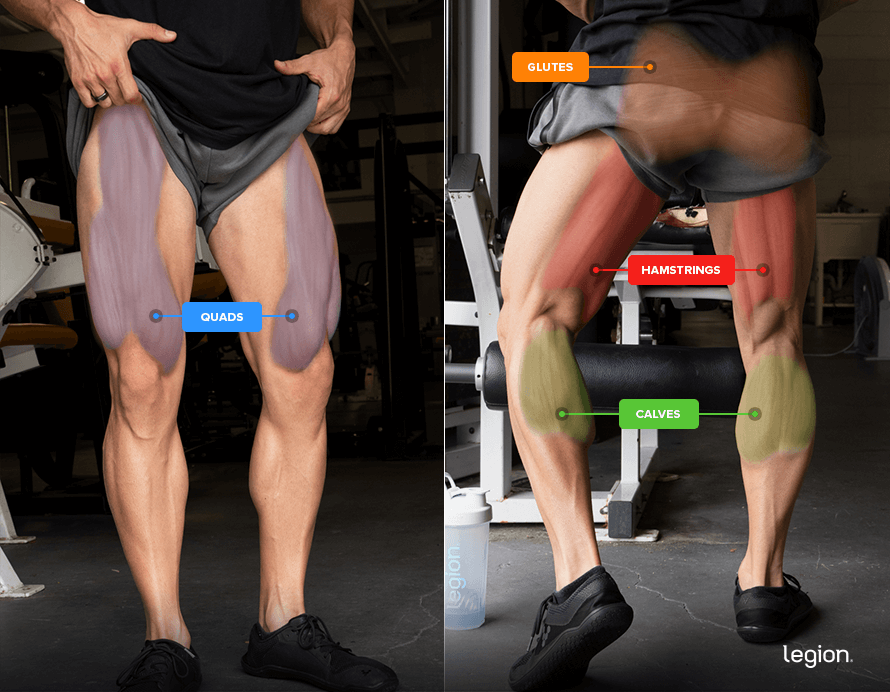
- Quads: The quads are a group of four muscles on the front of your thigh. Their main job is to extend (straighten) the knee, though they also assist hip flexion (bringing the thigh toward the chest).
- Gluteal muscles: Commonly known as the “glutes,” these are the three muscles making up your butt. Their primary functions are hip extension (moving the thigh backward) and hip abduction (moving the thighs away from each other). They also support internal and external rotation of the hip (they rotate your leg inward and outward)
- Hamstrings: The hamstrings are a group of three muscles on the back of your thigh. Their main functions are flexing (bending) the knee and extending the hip.
- Calves: Situated on the back of your lower legs, the calves consist of two muscles. Both muscles flex the ankle (point your toes), and one—the gastrocnemius—also contributes to knee flexion.
The Benefits of Leg Training
1. It develops balanced size and strength.
Many novice weightlifters prioritize noticeable upper-body muscles like the pecs, shoulders, and arms, and neglect leg training.
The consequence is that they build strong, muscular upper bodies that overshadow their weak, underdeveloped legs.
Training your legs ensures your upper and lower body gain size and strength at a similar clip, so there’s no weak point in your physique or performance.
2. It burns calories.
Most top-tier leg exercises train several major muscle groups at once and allow you to lift heavy weights safely.
Research shows that such exercises produce the greatest increases in metabolic rate, muscle mass, and strength. In other words, leg exercises are among the most effective exercises for burning calories and improving your body composition.
3. It improves your athletic performance.
Leg exercises improve your athletic performance in three ways:
- They help you develop lower-body power, speed, and strength.
- They train hip extension, which improves your ability to run, jump, climb, and so forth.
- They help you build lower-body stability, making you less prone to injury, so you can spend more time competing and less on the sidelines.
How to Structure a Leg Workout
Below is everything you need to know about how to organize leg exercises into effective lower-body workouts.
However, if you’d prefer to follow a ready-made and time-tested workout routine designed to help you build muscle and get strong, check out my fitness books for men and women, Bigger Leaner Stronger or Thinner Leaner Stronger.
Which Exercises Should You Include in Your Leg Workouts?
The lower body performs three fundamental movements:
- Squat: Bending at the hips and knees, like you’re sitting back into a chair.
- Hip hinge: Bending at the hips with minimal knee bend.
- Lunge: Taking a step forward, backward, or sideways and lowering your body by bending the knees.
By performing exercises that train these movement patterns in each lower-body workout, you ensure that you train all your lower-body muscles sufficiently.
How Many Sets and Reps Should You Do?
For optimal leg development, aim for 10-to-20 sets weekly.
Beginners (under 2 years of training) should target 10-to-15 sets weekly, while more experienced weightlifters (over 2 years of training) should aim for 15-to-20 sets.
How Many Times Should You Train Legs Per Week?
If you’re aiming for 10-to-15 weekly sets, doing them in one session should be challenging but doable.
If you’re aiming for more than 15 weekly sets, trying to do them in one workout is impractical. Instead, spread your sets across 2-to-3 weekly workouts.
The Best Leg Exercises
1. Barbell Back Squat
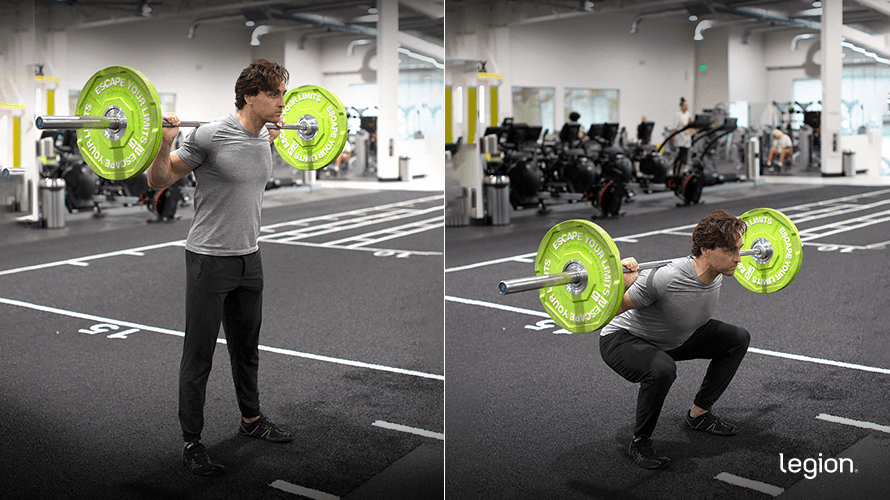
Why: The barbell back squat is the most effective leg exercise you can do because it allows you to lift heavy weights safely and progress regularly, which are vital for building muscle and strength.
How to:
- Position a barbell in a squat rack at about mid-chest height.
- Step under the bar, pinch your shoulder blades together, and rest the bar above the bony ridges on the bottom of your shoulder blades.
- Lift the bar out of the rack, take 1-to-2 steps backward, and place your feet a little wider than shoulder-width apart with your toes pointing slightly outward.
- Keeping your back straight, sit down and push your knees out in the same direction as your toes.
- Stand up and return to the starting position.
Sets and reps: 3 sets of 4-to-6 reps with 2-to-5 min rest
2. Barbell Front Squat
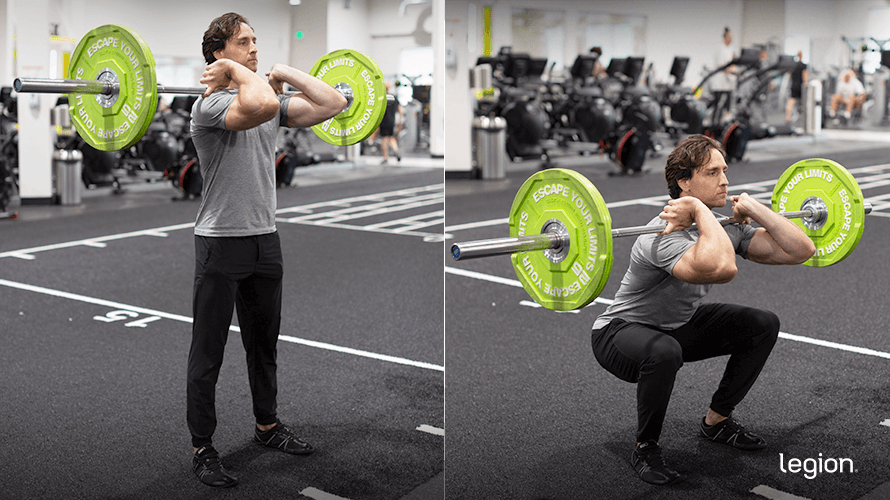
Why: The front squat trains the legs about as effectively as the back squat, even when you use up to 20% less weight. It also places significantly less compressive forces on your knees and lower back, which make it a particularly good leg exercise for those with back or knee issues.
How to:
- Position a barbell in a squat rack at about the height of your breastbone.
- Grab the bar with a shoulder-width grip and your palms facing away from you.
- Step closer to the bar so that it presses against the top of your breastbone and push your elbows up and out in front of the bar.
- With the bar resting on the front of your shoulders and held in place by your hands, lift it out of the rack, take 1-to-2 steps backward, and place your feet a little wider than shoulder-width apart with your toes pointing slightly outward.
- Keeping your back straight, sit down into a squat position and push your knees out in the same direction as your toes.
- Stand up and return to the starting position.
Sets and reps: 3 sets of 4-to-6 reps with 2-to-5 min rest
3. Deadlift
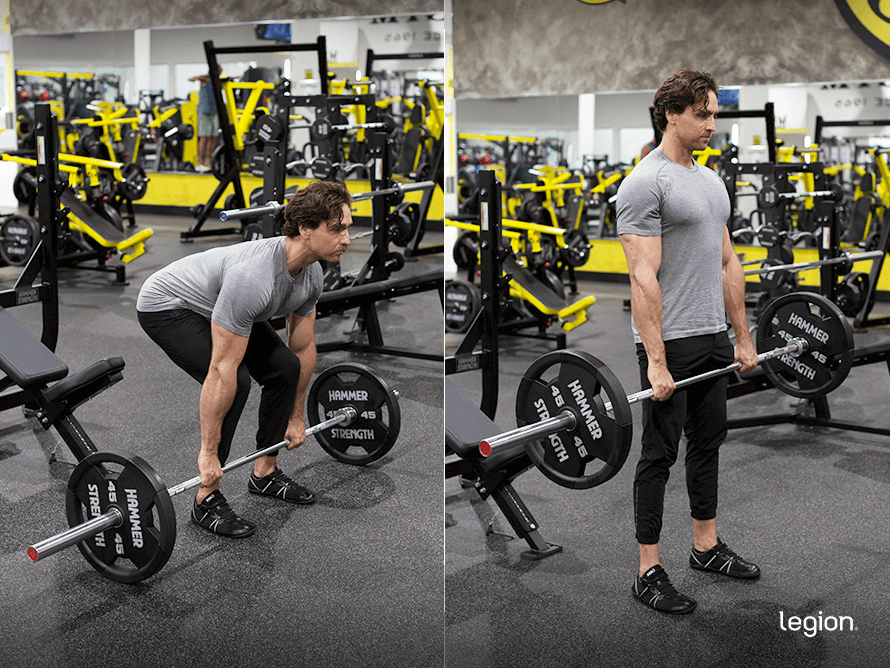
Why: The deadlift allows you to train your entire posterior chain (the muscles on the back of your body, including the hamstrings and glutes) with heavy weights safely and progress regularly, making it ideal for gaining size and strength.
How to:
- Position your feet slightly narrower than shoulder-width apart with your toes pointed slightly out.
- Move a loaded barbell over your midfoot, so it’s about an inch from your shins.
- Grip the bar just outside your shins with your palms facing you.
- Flatten your back and drive your body upward and slightly back by pushing through your heels until you’re standing up straight.
- Reverse the movement and return to the starting position.
Sets and reps: 3 sets of 4-to-6 reps with 2-to-5 min rest
4. Sumo Deadlift
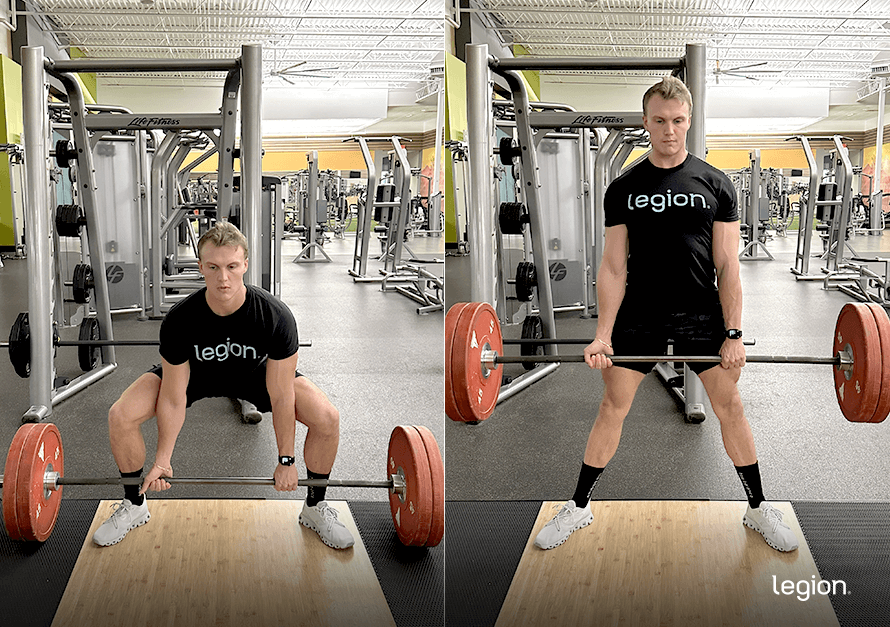
Why: The sumo deadlift trains your glutes and hamstrings similarly to the conventional deadlift, but places slightly more emphasis on your quads.
How to:
- Position your feet outside of shoulder-width apart and point your toes slightly outward, then move a loaded barbell over your midfoot.
- Drop your butt, letting your knees bend slightly while staying in line with your feet and keeping your back straight.
- Stand up while pulling the bar up your shins
- Reverse the movement and return to the starting position.
Sets and Reps: 3 sets of 4-to-6 reps with 2-to-5 min rest
5. Trap-Bar Deadlift
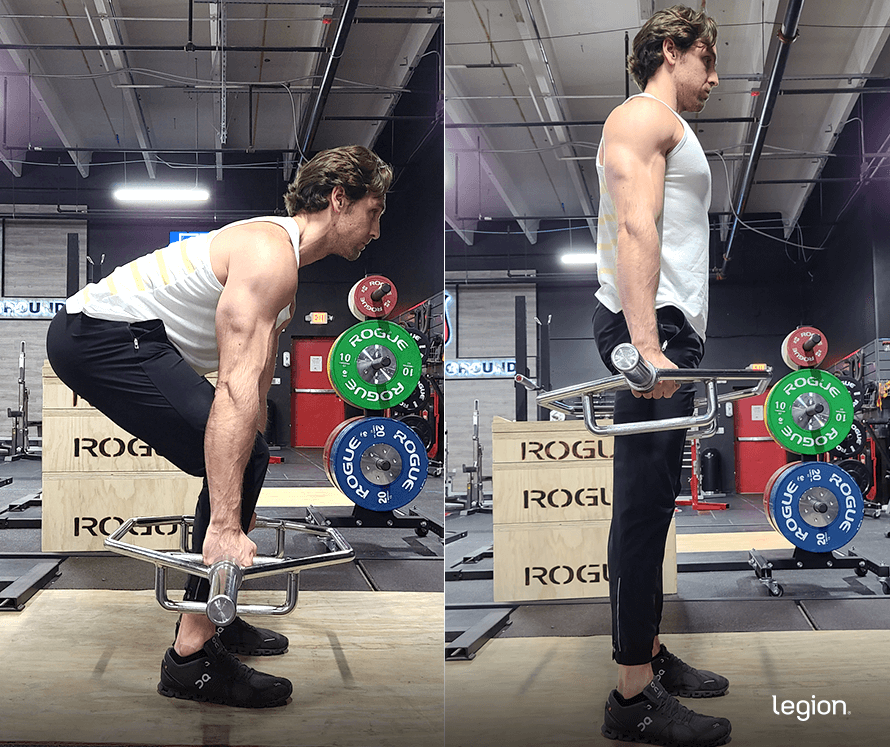
Why: The trap-bar deadlift engages the quads significantly more than other deadlift variations, and also trains the hamstrings and glutes to a high degree.
How to:
- Place your feet about shoulder-width apart inside the rectangular center of the trap bar.
- Push your hips back, arch your lower back slightly, and keep your shoulders back and down.
- Drive your body upward and slightly back, pushing your hips forward as the bar passes your knees.
- Reverse the movement and return to the starting position.
Sets and reps: 3 sets of 4-to-6 reps with 2-to-5 min rest
6. Romanian Deadlift
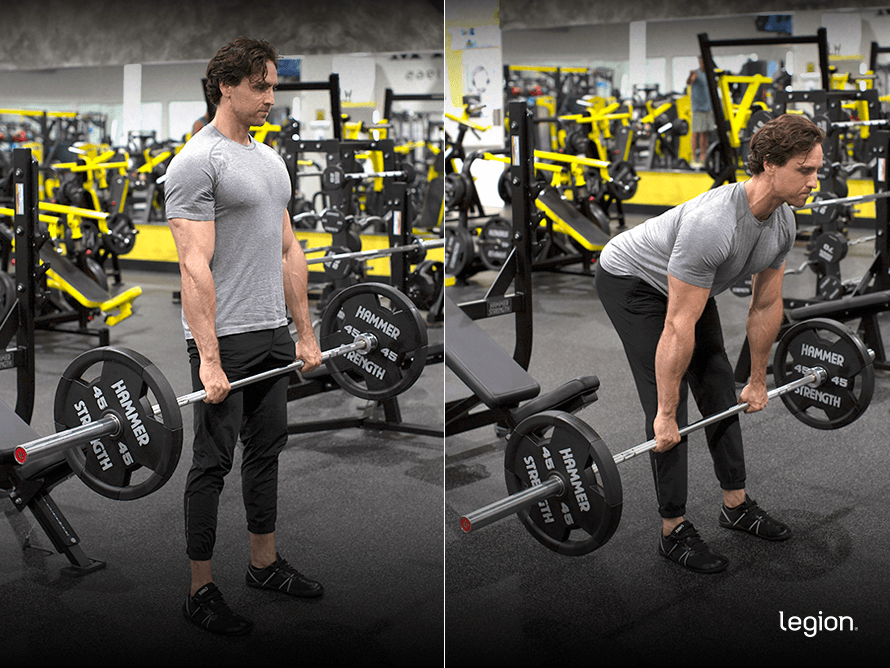
Why: The Romanian deadlift is an excellent exercise for developing the glutes and hamstrings. It’s also less fatiguing than other deadlift variations, which means you can do it more often without wearing yourself to a frazzle.
How to:
- Stand up straight with your feet hip-width apart and holding a loaded barbell with a shoulder-width grip and your palms facing toward you.
- Flatten your back and lower the weights toward the floor in a straight line while keeping your legs mostly straight, allowing your butt to move backward as you descend.
- Once you feel a stretch in your hamstrings, bend your knees slightly more, and continue lowering the weights until your lower back begins to round—just below the knees for most people and about mid-shin for those who are particularly flexible.
- Reverse the movement and return to the starting position.
Sets and reps: 3 sets of 4-to-6 reps with 2-to-3 min rest
7. Bulgarian Split Squat
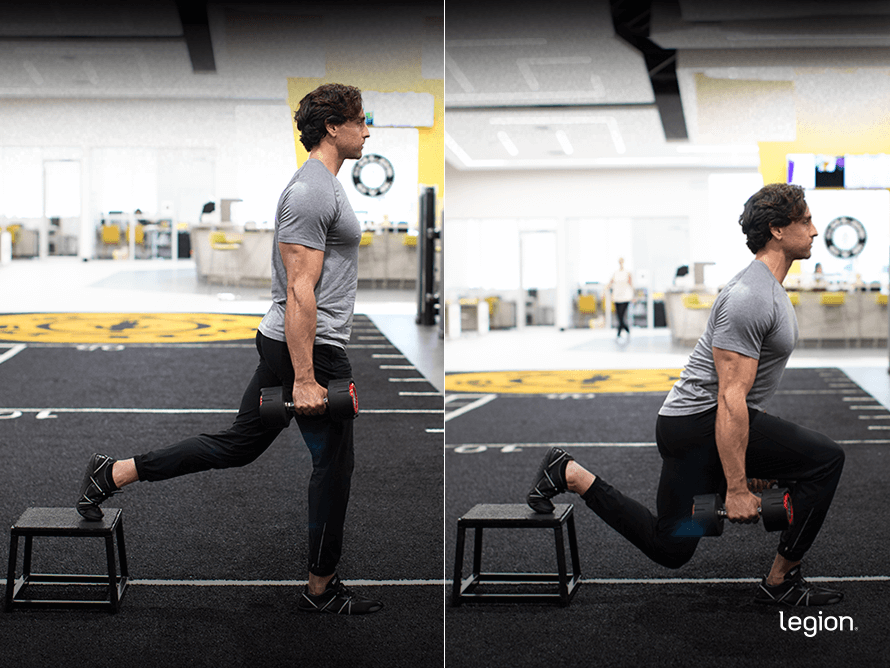
Why: The Bulgarian split squat trains your quads to a high degree, making it an excellent addition to your leg workouts. Because it’s a unilateral exercise, it’s also useful for finding and fixing muscle or strength imbalances.
How to:
- While holding a dumbbell in each hand, stand about 2-to-3 feet in front of a bench with your back to the bench.
- With your right foot planted, place the top of your left foot on the bench behind you.
- Lower your butt toward the floor by bending your right knee until your right thigh is roughly parallel with the floor.
- Stand up and return to the starting position.
Sets and reps: 3 sets of 4-to-6 reps with 2-to-3 min rest
8. Dumbbell Lunge
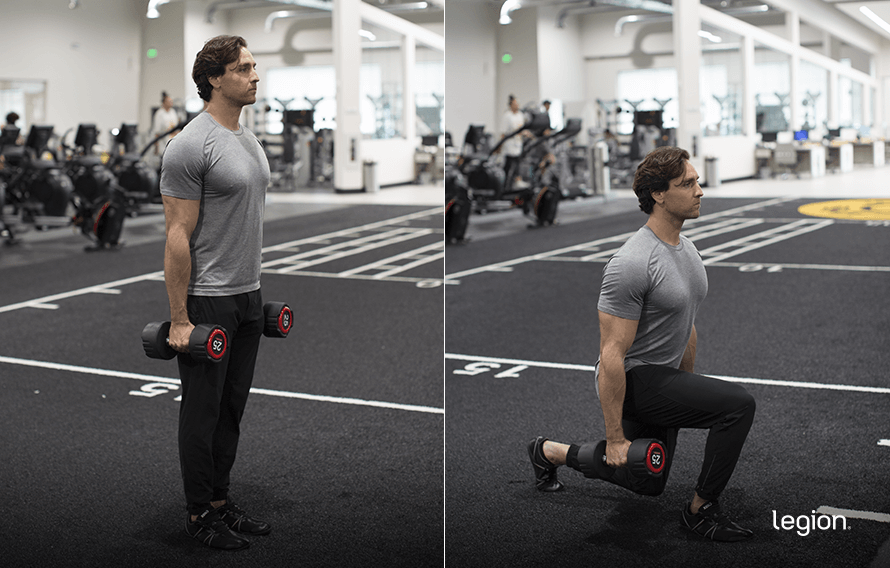
Why: The dumbbell lunge effectively trains your entire lower body, especially your quads. It’s also highly versatile (you can do forward, walking, or reverse lunges, for example), so you can always find a variation of the lunge that you like.
How to:
- Holding a dumbbell in each hand, stand with your feet about hip-width apart.
- Step 2-to-3 feet forward with your right foot.
- Bend both knees until your left knee touches the floor.
- Reverse the movement by pushing through your right foot and leaning slightly backward, allowing your legs to straighten.
- Once you’re in a standing position, bring your right foot back to the starting position.
Sets and reps: 3 sets of 6-to-8 reps with 2-to-3 min rest
9. Leg Press
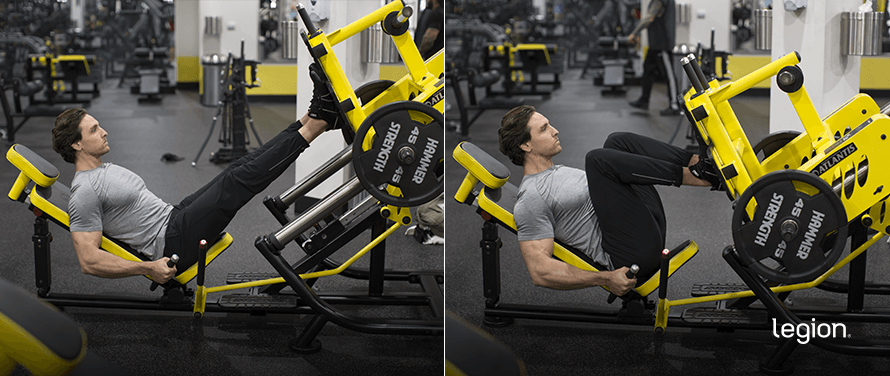
Why: The leg press is one of the best leg exercise machines because it allows you to train your lower body without balancing or supporting weight with your upper body, allowing you to use heavier loads than with other exercises, which is generally better for muscle growth.
How to:
- Wedge your butt down into the base of the leg press machine seat.
- Place your feet halfway up the footplate a little wider than shoulder-width apart with your toes pointing slightly outward.
- Straighten your knees and use the safety handles to release the weight.
- Lower the footplate toward your torso until your thighs are about 12-to-18 inches from your chest.
- Push the footplate upward until your legs are almost but not completely straight (knees slightly bent).
Sets and reps: 3 sets of 4-to-6 reps with 2-to-3 min rest
10. Hack Squat
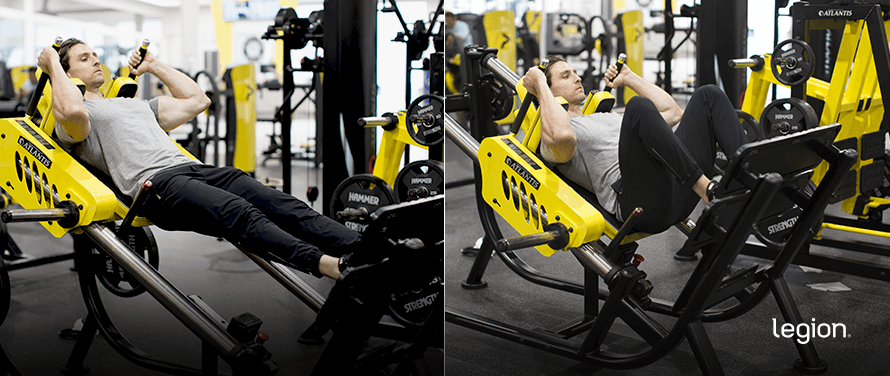
Why: The hack squat is another top-tier leg exercise machine because it trains all your lower-body muscle groups without stressing your knees and back as much as other free-weight squatting exercises.
How to:
- Position your body so that your feet are shoulder-width apart on the hack squat machine footplate with your toes pointing slightly outward, and your shoulders and back are against the pads.
- Straighten your knees and use the safety handles to release the weight.
- Keeping your back against the pad, sit down and push your knees out in the same direction as your toes.
- Stand up and return to the starting position.
Sets and reps: 3 sets of 4-to-6 reps with 2-to-3 min rest
11. Dumbbell Step-up
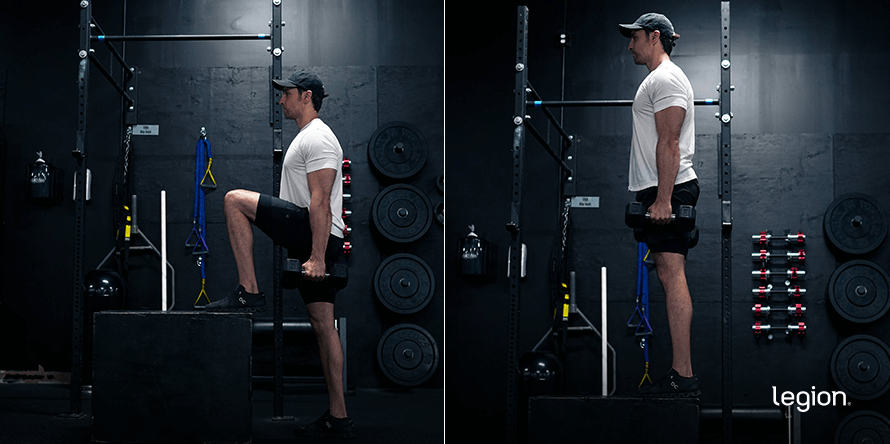
Why: The dumbbell step-up trains your entire lower body, helps eliminate size and strength imbalances, boosts your squat performance, and is easier on your knees and back than many other lower-body exercises.
How to:
- Holding a dumbbell in each hand, place your right foot on a box, bench, or other surface about knee-height off the floor.
- Keeping your weight on your right foot, fully straighten your right leg.
- Lower your left foot toward the floor, and return to the starting position.
Sets and reps: 3 sets of 6-to-8 reps with 2-to-3 min rest
12. Split Squat
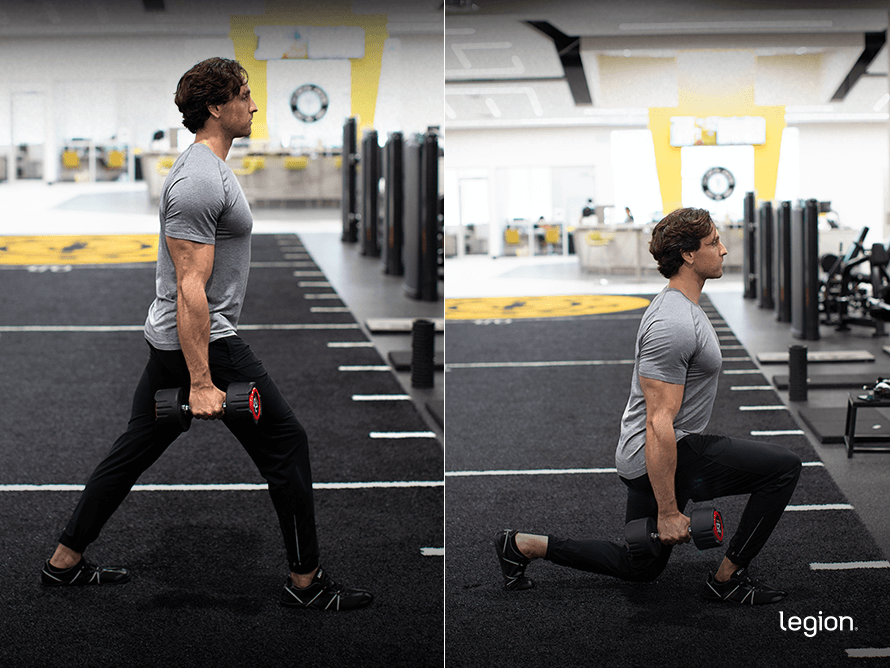
Why: The dumbbell split squat allows you to train all your leg muscles one leg at a time, helping you build balanced size and strength.
How to:
- Holding a dumbbell in each hand, stand with your feet about shoulder-width apart.
- Take a long step forward with your right foot—about 2-to-3 feet. Keeping your weight on your front foot, bend both knees until your left knee touches the floor.
- Reverse the motion by pushing through your right heel to straighten your legs and return to the starting position.
- Once you’ve performed the desired number of reps, switch legs and repeat the process.
Sets and reps: 3 sets of 6-to-8 reps with 2-to-3 min rest
13. Goblet Squat
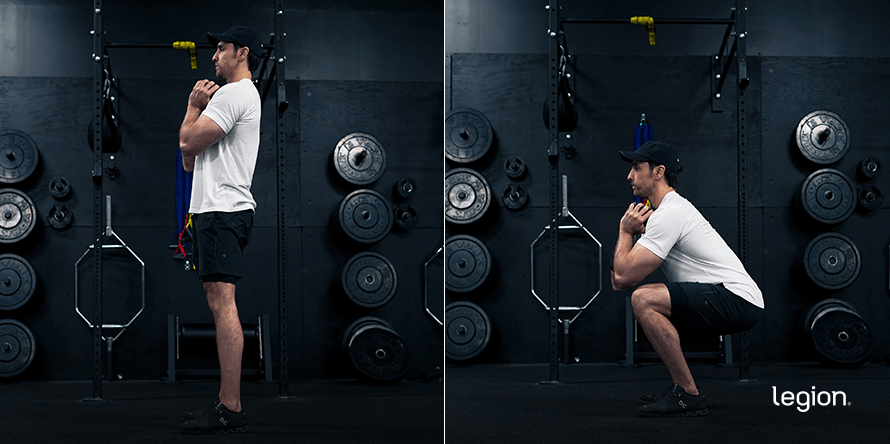
Why: The goblet squat is an effective exercise for training your entire lower-body, particularly your quads. It’s also easier on your back than other squat variations.
How to:
- Hold a dumbbell in front of your chest with both hands.
- Place your feet a little wider than shoulder-width apart, point your toes slightly outward, and raise your chest.
- Keeping your back straight, sit down and push your knees out in the same direction as your toes.
- Stand up and return to the starting position.
Sets and reps: 3 sets of 8-to-10 reps with 2-to-3 min rest
14. Good Morning
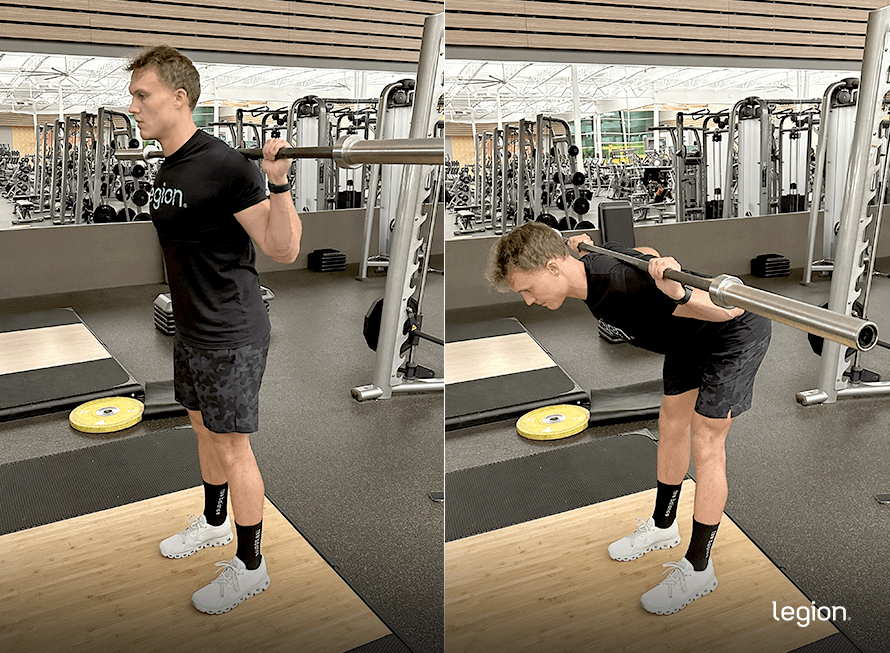
Why: The good morning allows you to train your glutes and hamstrings with heavy weights and in a stretched position, which is beneficial for muscle growth.
How to:
- Adjust the hooks in a squat rack so the bar is at mid-chest height.
- Get under the bar and position it across your mid-traps and rear delts so it rests right above the little ridges on the back of your shoulder blades.
- Grip the bar with your palms facing away from you.
- Unrack the bar, take 1-to-2 steps backward, and position your feet about shoulder-width apart.
- With slightly bent knees, move your butt backward so your torso can “hinge” forward and lower the bar in a straight line toward the ground.
- Once you can’t lower the bar any further without bending your back, reverse the movement and return to the starting position.
Sets and Reps: 3 sets of 4-to-6 reps with 2-to-3 min rest
15. Hip Thrust
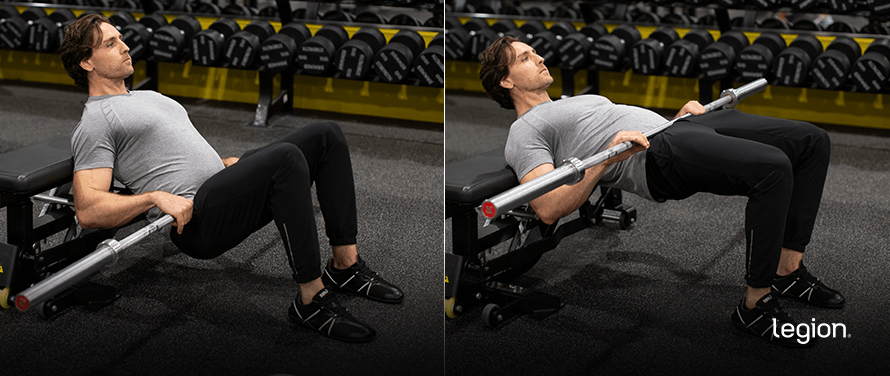
Why: The positioning of the barbell during hip thrusts forces your glutes to work hard throughout the entire range of motion, which is a unique benefit of this exercise.
How to:
- Sit on the ground with your shoulders resting against a bench that’s perpendicular to your body.
- Roll a barbell over your thighs so it sits in your hip crease (use a bar pad to protect your hip bones and make the exercise more comfortable).
- Plant your feet on the floor about shoulder-width apart and 12-to-18 inches from your butt so your knees are bent to about 90 degrees.
- Push the bar upward with your hips by pressing through your heels until your upper body and thighs are parallel to the ground and your shins are vertical.
- Reverse the movement and return to the starting position.
Sets and reps: 3 sets of 6-to-8 reps with 2-to-3 min rest
16. Glute Bridge
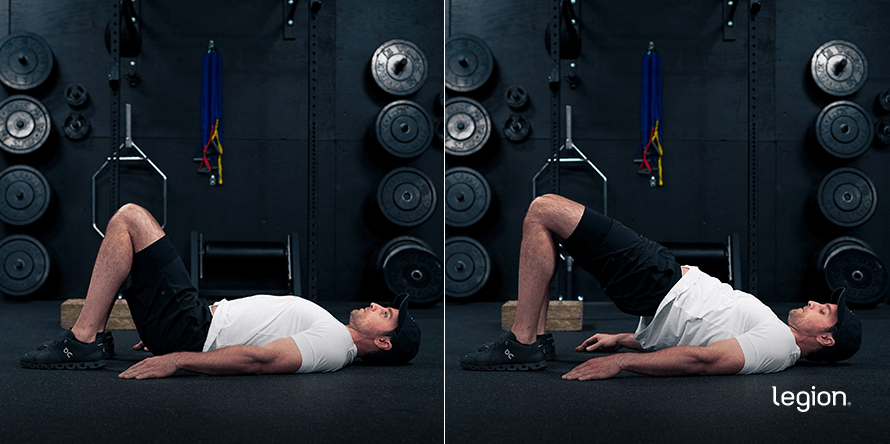
Why: The glute bridge is a useful glute isolation exercise because it’s easy to learn, lets you start with your body weight, and strengthens your glutes effectively.
How to:
- Lie on your back on the floor with your arms by your sides and your palms facing the floor.
- Place your feet 15-to-18 inches apart, about 6-to-12 inches from your butt, and point your toes slightly outward.
- Lift your butt off the floor by pressing your shoulders and heels into the floor, pushing your knees out in the same direction as your toes, and squeezing your glutes.
- Continue thrusting your hips upward until your butt, hips, and knees form a straight line and your shins are vertical.
- Reverse the movement and return to the starting position.
Sets and reps: 3 sets of 10-to-20 reps with 2-to-3 min rest
17. Sissy Squat
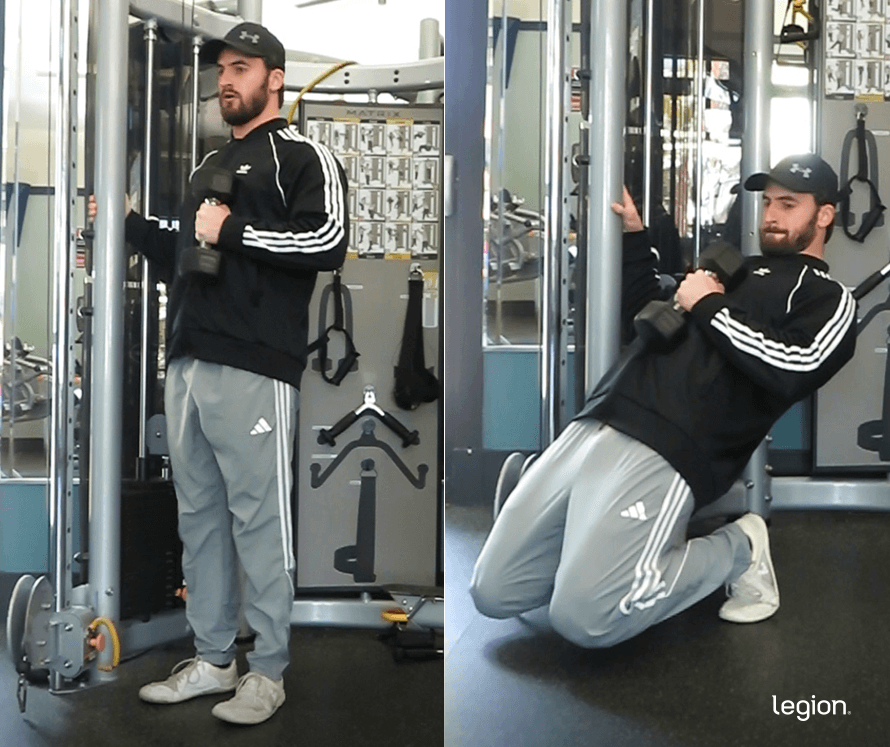
Why: The sissy squat trains your quads through a full range of motion and in a stretched position, which is important for maximizing growth.
How to:
- Stand with your feet shoulder-width apart, holding onto a sturdy object with your dominant hand.
- Squeeze your glutes, then bend your knees, allowing them to move forward over your toes.
- As you descend, lean backward, and let your heels come off the floor.
- Lower yourself until your glutes are 6-to-12 inches from your heels.
- Reverse the movement and return to the starting position.
Sets and reps: 3 sets of 10-to-20 reps with 2-to-3 min rest
18. Leg Curl
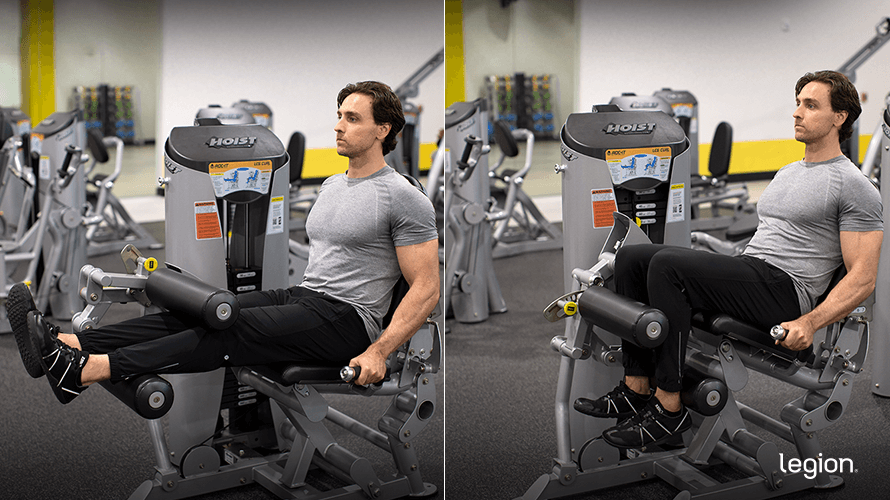
Why: Unlike most hamstring exercises, the seated leg curl trains your hamstrings through a full range of motion and in a stretched position, which it’s highly effective for gaining hamstring size and strength.
How to:
- Sit on the leg curl machine with the back of your knees a couple of inches off the pad supporting your thighs and adjust the heel pad so it’s across your Achilles tendons.
- Press your heels toward your butt until your shins are roughly perpendicular to your thighs (or closer)
- Raise your heels and return to the starting position.
Sets and reps: 3 sets of 6-to-8 reps with 2-to-3 min rest
19. Nordic Hamstring Curl
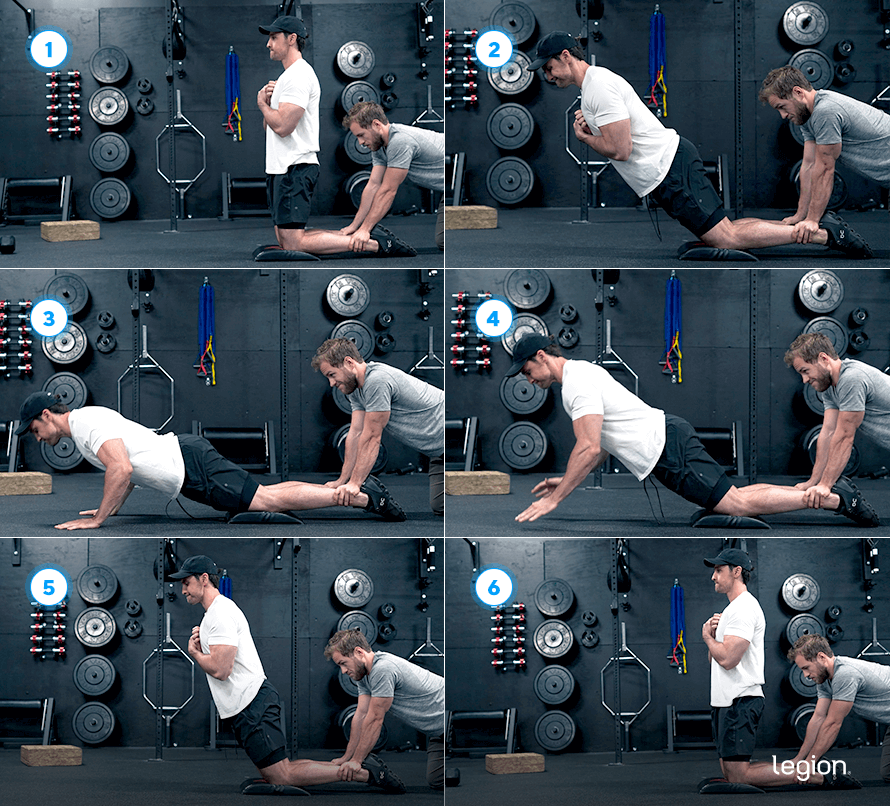
Why: Research shows that the Nordic leg curl is a fantastic bodyweight hamstring exercise, which may also reduce your risk of suffering a hamstring injury.
How to:
- Kneel on a yoga mat or cushioned pad facing away from your training partner and have your partner hold your legs around your ankles and pin your feet to the floor.
- Place your hands in front of your chest, then while flexing your glutes, hamstrings, and abs and maintaining a straight line between your head and knees, lower your chest toward the floor by leaning forward, using your hamstrings to ensure the movement is slow and controlled.
- As you near the floor, put your hands out to catch your body and prevent your chest from hitting the floor.
- While maintaining the straight line between your head and knees, pull your body back to the starting position using your hamstrings. (If necessary, push off the floor with your hands to initiate the curl.)
Sets and reps: 3 sets of 10-to-20 reps with 2-to-3 min rest
20. Seated Calf Raise
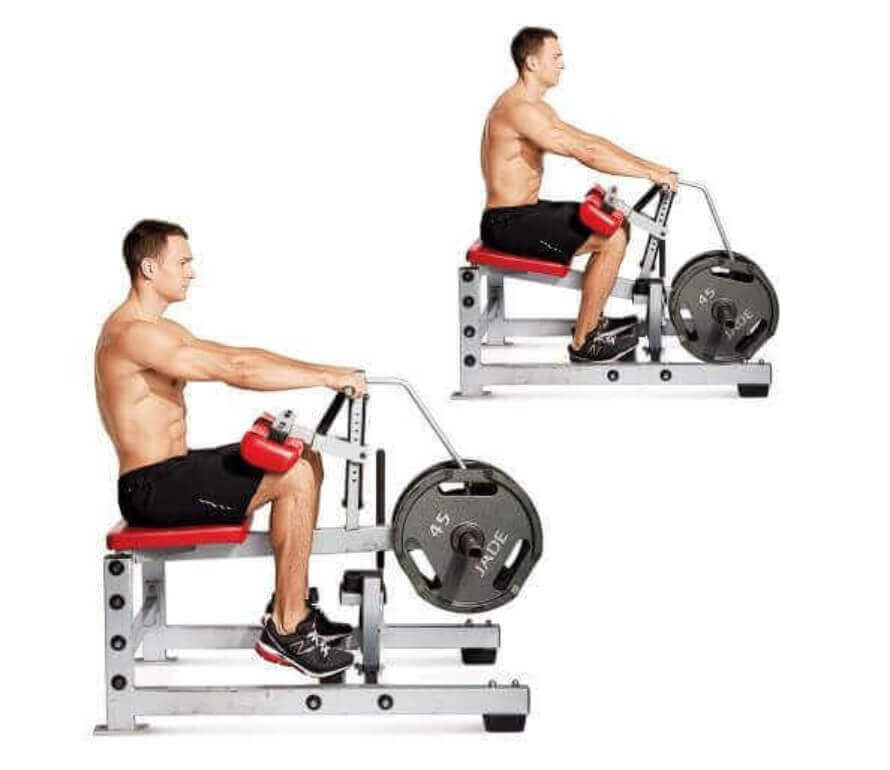
Why: The seated calf raise machine trains both your calf muscles but emphasizes the soleus, which contributes more than the gastrocnemius to the overall size of your calves.
How to:
- While seated, adjust the thigh pad so that it rests just above your knee and place the balls of your feet on the footplate.
- Lift the pad slightly by pointing your toes, and use the safety handle to release the weight.
- While keeping your feet on the footplate, lower the weight as far as possible by lowering your heels toward the floor.
- Push through the balls of your feet to elevate the thigh pad as high as you can, and then lower your heels to return to the starting position.
Sets and reps: 3 sets of 6-to-8 reps with 2-to-3 min rest
The Best Supplements for Optimizing Leg Training
You don’t need supplements to build lower-body muscle—but the right ones can make both easier, faster, and more enjoyable.
Here are some of the best options to consider
- Protein powder: Protein powder, such as Whey+ (Legion’s whey isolate) or Casein+ (Legion’s micellar casein), provides your body with the nutrients needed to build muscle tissue and recover from workouts.
- Creatine: Creatine boosts muscle and strength gain, improves anaerobic endurance, and reduces muscle damage and soreness from your workouts. For a natural source of creatine, try Legion’s creatine monohydrate, creatine gummies, or post-workout Recharge.
- Pre-workout: A high-quality pre-workout enhances energy, mood, and focus, increases strength and endurance, and reduces fatigue. For a top-tier pre-workout containing clinically effective doses of 6 science-backed ingredients, try Legion’s Pulse with caffeine or without.
(If you’d like even more specific advice about which supplements you should take to reach your health and fitness goals, take the Legion Supplement Finder Quiz, and in less than a minute, you’ll know exactly what supplements are right for you.)
Scientific References +
- Kary, Joel M. “Diagnosis and Management of Quadriceps Strains and Contusions.” Current Reviews in Musculoskeletal Medicine, vol. 3, no. 1-4, 30 July 2010, pp. 26–31, www.ncbi.nlm.nih.gov/pmc/articles/PMC2941577/pdf/12178_2010_Article_9064.pdf, https://doi.org/10.1007/s12178-010-9064-5.
- Elzanie, Adel, and Judith Borger. “Anatomy, Bony Pelvis and Lower Limb, Gluteus Maximus Muscle.” PubMed, StatPearls Publishing, 2021, www.ncbi.nlm.nih.gov/books/NBK538193/.
- Afonso, José, et al. “The Hamstrings: Anatomic and Physiologic Variations and Their Potential Relationships with Injury Risk.” Frontiers in Physiology, vol. 12, 7 July 2021, https://doi.org/10.3389/fphys.2021.694604.
- Li, Li, et al. “The Function of Gastrocnemius as a Knee Flexor at Selected Knee and Ankle Angles.” Journal of Electromyography and Kinesiology, vol. 12, no. 5, Oct. 2002, pp. 385–390, www.sciencedirect.com/science/article/pii/S1050641102000494, https://doi.org/10.1016/s1050-6411(02)00049-4. Accessed 3 Jan. 2020.
- Farinatti, Paulo TV, and Antonio G Castinheiras Neto. “The Effect of Between-Set Rest Intervals on the Oxygen Uptake during and after Resistance Exercise Sessions Performed with Large- and Small-Muscle Mass.” Journal of Strength and Conditioning Research, vol. 25, no. 11, Nov. 2011, pp. 3181–3190, https://doi.org/10.1519/jsc.0b013e318212e415.
- MARX, JAMES O., et al. “Low-Volume Circuit versus High-Volume Periodized Resistance Training in Women.” Medicine and Science in Sports and Exercise, Apr. 2001, pp. 635–643, https://doi.org/10.1097/00005768-200104000-00019.
- Kirkpatrick, John , and Paul Comfort. Strength, Power, and Speed Qualities in English Junior Elite Rugby League Players. Dec. 2012, https://doi.org/10.1519/JSC.0b013e3182804a6d.
- Wisloff, U, et al. “Strong Correlation of Maximal Squat Strength with Sprint Performance and Vertical Jump Height in Elite Soccer Players.” British Journal of Sports Medicine, vol. 38, no. 3, 1 June 2004, pp. 285–288.
- Seitz, Laurent B., et al. “Increases in Lower-Body Strength Transfer Positively to Sprint Performance: A Systematic Review with Meta-Analysis.” Sports Medicine, vol. 44, no. 12, 25 July 2014, pp. 1693–1702, https://doi.org/10.1007/s40279-014-0227-1.
- Delgado, Jose , et al. Comparison between Back Squat, Romanian Deadlift, and Barbell Hip Thrust for Leg and Hip Muscle Activities during Hip Extension. July 2019, https://doi.org/10.1519/JSC.0000000000003290.
- Behrens, Matthew J, and Shawn R Simonson. “A Comparison of the Various Methods Used to Enhance Sprint Speed.” Strength and Conditioning Journal, vol. 33, no. 2, Apr. 2011, pp. 64–71, https://doi.org/10.1519/ssc.0b013e318210174d.
- Gallego-Izquierdo, Tomás, et al. “Effects of a Gluteal Muscles Specific Exercise Program on the Vertical Jump.” International Journal of Environmental Research and Public Health, vol. 17, no. 15, 1 Jan. 2020, p. 5383, www.mdpi.com/1660-4601/17/15/5383, https://doi.org/10.3390/ijerph17155383. Accessed 14 Dec. 2020.
- Bartlett, Jamie L., et al. “Activity and Functions of the Human Gluteal Muscles in Walking, Running, Sprinting, and Climbing.” American Journal of Physical Anthropology, vol. 153, no. 1, 12 Nov. 2013, pp. 124–131, https://doi.org/10.1002/ajpa.22419.
- ESCAMILLA, RAFAEL F. “Knee Biomechanics of the Dynamic Squat Exercise.” Medicine and Science in Sports and Exercise, vol. 33, no. 1, Jan. 2001, pp. 127–141, https://doi.org/10.1097/00005768-200101000-00020.
- Hartmann, Hagen, et al. “Analysis of the Load on the Knee Joint and Vertebral Column with Changes in Squatting Depth and Weight Load.” Sports Medicine, vol. 43, no. 10, 3 July 2013, pp. 993–1008, www.deepdyve.com/lp/springer-journals/analysis-of-the-load-on-the-knee-joint-and-vertebral-column-with-zkgXYldF90, https://doi.org/10.1007/s40279-013-0073-6. Accessed 14 Sept. 2019.
- “N.S.C.A. POSITION PAPER: The Squat Exercise in Athletic Conditioning: A Position Statement and Review of the Literature.” Strength & Conditioning Journal, vol. 13, no. 5, 1 Oct. 1991, pp. 51–58, journals.lww.com/nsca-scj/Citation/1991/10000/N_S_C_A__POSITION_PAPER__The_Squat_Exercise_in.11.aspx. Accessed 26 Nov. 2021.
- Yavuz, Hasan Ulas, et al. “Kinematic and EMG Activities during Front and Back Squat Variations in Maximum Loads.” Journal of Sports Sciences, vol. 33, no. 10, 29 Jan. 2015, pp. 1058–1066, www.growkudos.com/publications/10.1080%25252F02640414.2014.984240/reader, https://doi.org/10.1080/02640414.2014.984240.
- Gullett, Jonathan C, et al. “A Biomechanical Comparison of Back and Front Squats in Healthy Trained Individuals.” Journal of Strength and Conditioning Research, vol. 23, no. 1, Jan. 2009, pp. 284–292, journals.lww.com/nsca-jscr/fulltext/2009/01000/A_Biomechanical_Comparison_of_Back_and_Front.41.aspx, https://doi.org/10.1519/jsc.0b013e31818546bb.
- Cholewicki, J., et al. “Lumbar Spine Loads during the Lifting of Extremely Heavy Weights.” Medicine and Science in Sports and Exercise, vol. 23, no. 10, 1 Oct. 1991, pp. 1179–1186, pubmed.ncbi.nlm.nih.gov/1758295/.
- Swinton, Paul A, et al. “A Biomechanical Analysis of Straight and Hexagonal Barbell Deadlifts Using Submaximal Loads.” Journal of Strength and Conditioning Research, vol. 25, no. 7, July 2011, pp. 2000–2009, https://doi.org/10.1519/jsc.0b013e3181e73f87.
- Jones, Margaret T, et al. “Effects of Unilateral and Bilateral Lower-Body Heavy Resistance Exercise on Muscle Activity and Testosterone Responses.” Journal of Strength and Conditioning Research, vol. 26, no. 4, Apr. 2012, pp. 1094–1100, https://doi.org/10.1519/jsc.0b013e318248ab3b.
- Marchetti, Paulo H., et al. “Balance and Lower Limb Muscle Activation between In-Line and Traditional Lunge Exercises.” Journal of Human Kinetics, vol. 62, no. 1, 13 June 2018, pp. 15–22, content.sciendo.com/view/journals/hukin/62/1/article-p15.xml, https://doi.org/10.1515/hukin-2017-0174.
- Deniz Erdağ, and Hasan Ulaş Yavuz. “Evaluation of Muscle Activities during Different Squat Variations Using Electromyography Signals.” ResearchGate, unknown, 2020, www.researchgate.net/publication/337400852_Evaluation_of_Muscle_Activities_During_Different_Squat_Variations_Using_Electromyography_Signals.
- Simenz, Christopher J., et al. “Electromyographical Analysis of Lower Extremity Muscle Activation during Variations of the Loaded Step-up Exercise.” Journal of Strength and Conditioning Research, vol. 26, no. 12, Dec. 2012, pp. 3398–3405, https://doi.org/10.1519/jsc.0b013e3182472fad.
- Collins, Kyle S., et al. “Differences in Muscle Activity and Kinetics between the Goblet Squat and Landmine Squat in Men and Women.” Journal of Strength and Conditioning Research, vol. Publish Ahead of Print, 2 Aug. 2021, https://doi.org/10.1519/jsc.0000000000004094.
- Schellenberg, Florian, et al. “Towards Evidence Based Strength Training: A Comparison of Muscle Forces during Deadlifts, Goodmornings and Split Squats.” BMC Sports Science, Medicine and Rehabilitation, vol. 9, no. 1, 17 July 2017, https://doi.org/10.1186/s13102-017-0077-x.
- Ebben, William P. “Hamstring Activation during Lower Body Resistance Training Exercises.” International Journal of Sports Physiology and Performance, vol. 4, no. 1, Mar. 2009, pp. 84–96, https://doi.org/10.1123/ijspp.4.1.84.
- Contreras, Bret, et al. “Barbell Hip Thrust.” Strength and Conditioning Journal, vol. 33, no. 5, Oct. 2011, pp. 58–61, https://doi.org/10.1519/ssc.0b013e31822fa09d.
- Lehecka, Bryan J., et al. “The Effects of Gluteal Squeezes Compared to Bilateral Bridges on Gluteal Strength, Power, Endurance, and Girth.” PeerJ, vol. 7, 8 July 2019, p. e7287, https://doi.org/10.7717/peerj.7287.
- Pedrosa, Gustavo F., et al. “Partial Range of Motion Training Elicits Favorable Improvements in Muscular Adaptations When Carried out at Long Muscle Lengths.” European Journal of Sport Science, 23 May 2021, pp. 1–11, pubmed.ncbi.nlm.nih.gov/33977835/, https://doi.org/10.1080/17461391.2021.1927199.
- Maeo, Sumiaki, et al. “Greater Hamstrings Muscle Hypertrophy but Similar Damage Protection after Training at Long versus Short Muscle Lengths.” Medicine & Science in Sports & Exercise, vol. 53, no. 4, 2 Oct. 2020, pp. 825–837, https://doi.org/10.1249/mss.0000000000002523.
- Yanagisawa, Osamu, and Atsuki Fukutani. “Muscle Recruitment Pattern of the Hamstring Muscles in Hip Extension and Knee Flexion Exercises.” Journal of Human Kinetics, vol. 72, no. 1, 31 Mar. 2020, pp. 51–59, https://doi.org/10.2478/hukin-2019-0124. Accessed 8 Oct. 2020.
- Cuthbert, Matthew, et al. “The Effect of Nordic Hamstring Exercise Intervention Volume on Eccentric Strength and Muscle Architecture Adaptations: A Systematic Review and Meta-Analyses.” Sports Medicine, vol. 50, no. 1, 9 Sept. 2019, https://doi.org/10.1007/s40279-019-01178-7.
- Miyamoto, Naokazu, and Shingo Oda. “Mechanomyographic and Electromyographic Responses of the Triceps Surae during Maximal Voluntary Contractions.” Journal of Electromyography and Kinesiology, vol. 13, no. 5, Oct. 2003, pp. 451–459, https://doi.org/10.1016/s1050-6411(03)00058-0. Accessed 12 Nov. 2019.










